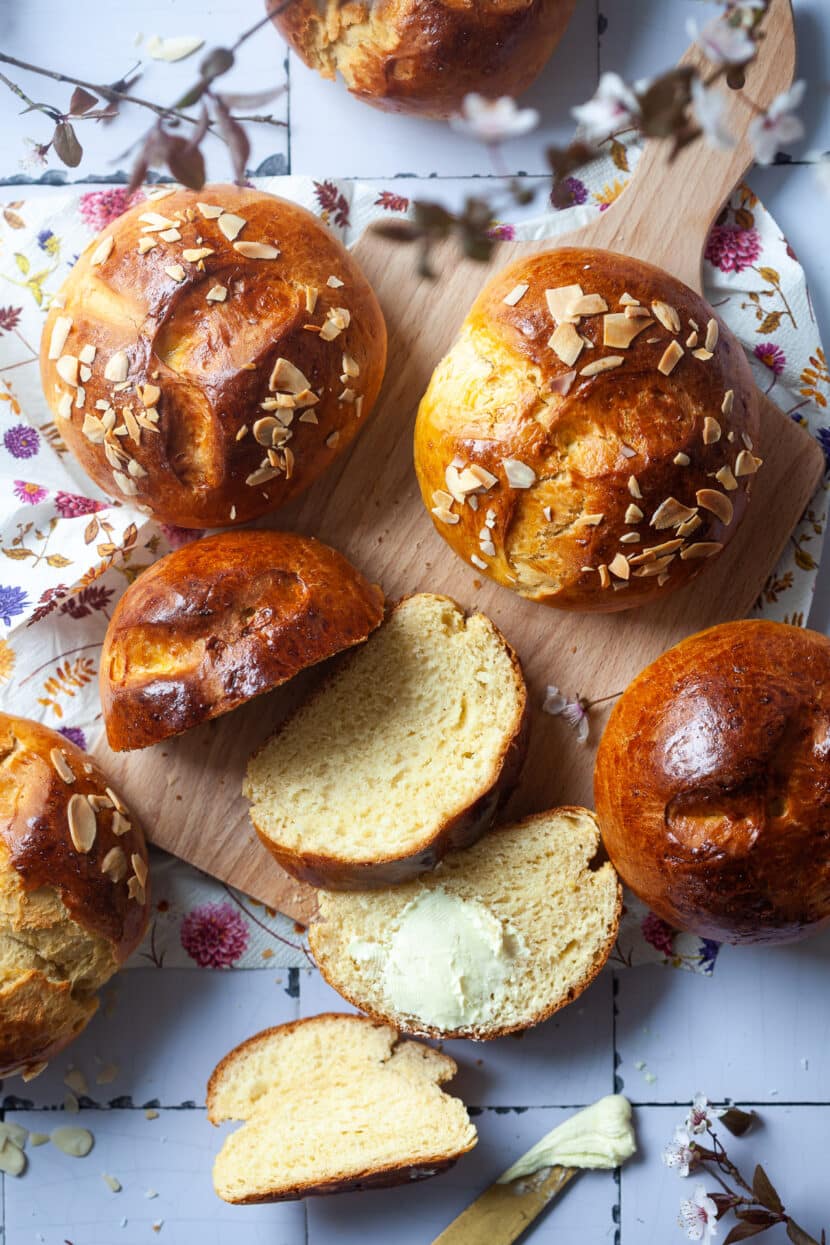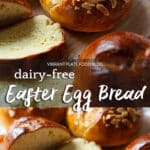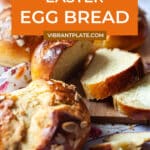This Dairy-Free Easter Egg Bread is our family’s traditional recipe and my favorite Easter dish. Try this easy and quick recipe!
My favorite Easter dish is this soft and sweet brioche dough that can be shaped into buns, formed into wreaths, or braided!
This Dairy-Free Easter Egg Bread is a traditional Italian recipe that my family has been making for years! It is also known as Italian Easter bread or Pane di Pasqua, and it is a festive and delicious bread traditionally enjoyed during the Easter holiday season.
This recipe is usually made with dairy products such as milk and butter, but it’s been many years since I have switched to plant-based butter and milk.
It is very simple to make, but it does take a little time for the dough to rise. Still, you can mix the ingredients in the morning, and have the buns freshly baked by lunch for a tasty afternoon snack with your coffee.
But don’t limit yourself to making it just for Easter, this sweet brioche is delicious to have any time of the year!
This recipe is not vegan, as it uses eggs, but it is dairy-free! When using eggs, we always use free-range organic eggs from the local farm, so it is as cruelty-free as possible.
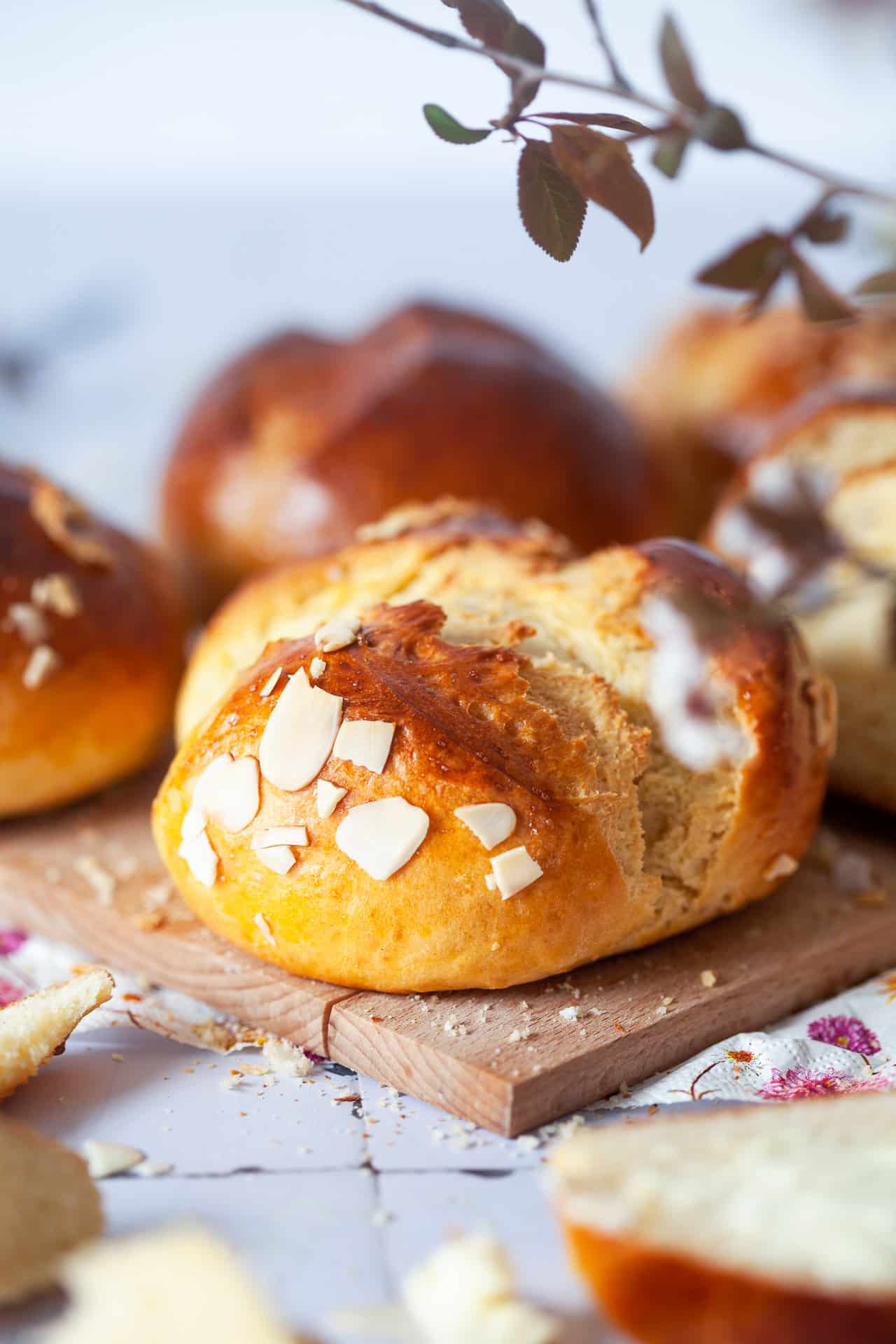
Dairy-Free Easter Egg Bread Ingredients
To make this recipe you will need:
- Vegan Butter: Adds richness and moisture to the bread, mimicking the role of traditional butter. It contributes to the flavor and tender texture. We like to use the brands Naturli or Violife best when baking.
- Soy Milk: Provides liquid for the dough. Soy milk adds a creamy texture and also helps in activating the yeast. Other kinds of milk will also work, but we have the best results with soy milk when baking.
- Eggs: add richness, color, and structure to the bread. The fats in the yolks contribute to a softer crumb, while the proteins help in structure formation. A beaten egg is also used for an egg wash on the bread’s surface before baking. This contributes to a shiny, golden-brown crust, enhancing visual appeal.If you want to keep this recipe vegan, you can skip the egg and instead add a little more soy milk and vegan butter. I would also recommend adding a tiny pinch of turmeric for a nice golden hue to the baked bread.
- Sugar: Sweetens the bread and also feeds the yeast, aiding in the fermentation process. The sugar contributes to the overall flavor and helps achieve a golden crust. Regular granulated sugar works best.
- Vanilla Sugar: Enhances the flavor of the bread with a hint of vanilla. It adds a subtle aromatic note to the dough. This is just sugar mixed with vanilla, you can also swap for 1 tsp vanilla extract or paste.
- Dark Rum: Introduces a depth of flavor and aroma. Rum complements the sweetness and adds a unique richness to the bread. This ingredient is optional for flavor, but it is traditional in this recipe.
- Lemon Zest: Provides a bright, citrusy flavor that balances the sweetness. The acidity in the zest can also react with the yeast for improved leavening.
- Yeast: Serves as the leavening agent, allowing the bread to rise. The yeast ferments the sugars, producing carbon dioxide that creates a light and airy texture. We use dry yeast as it is convenient to keep, but fresh yeast works just as well. Choose the one you like best.
- Flour: Forms the structure of the bread. The gluten in the flour provides elasticity and strength to the dough, resulting in a well-textured bread. Use all-purpose flour or a specialty flour for baked sweets.
- Salt: Enhances the overall flavor by balancing the sweetness and suppressing any bitterness. Salt also strengthens the gluten structure.
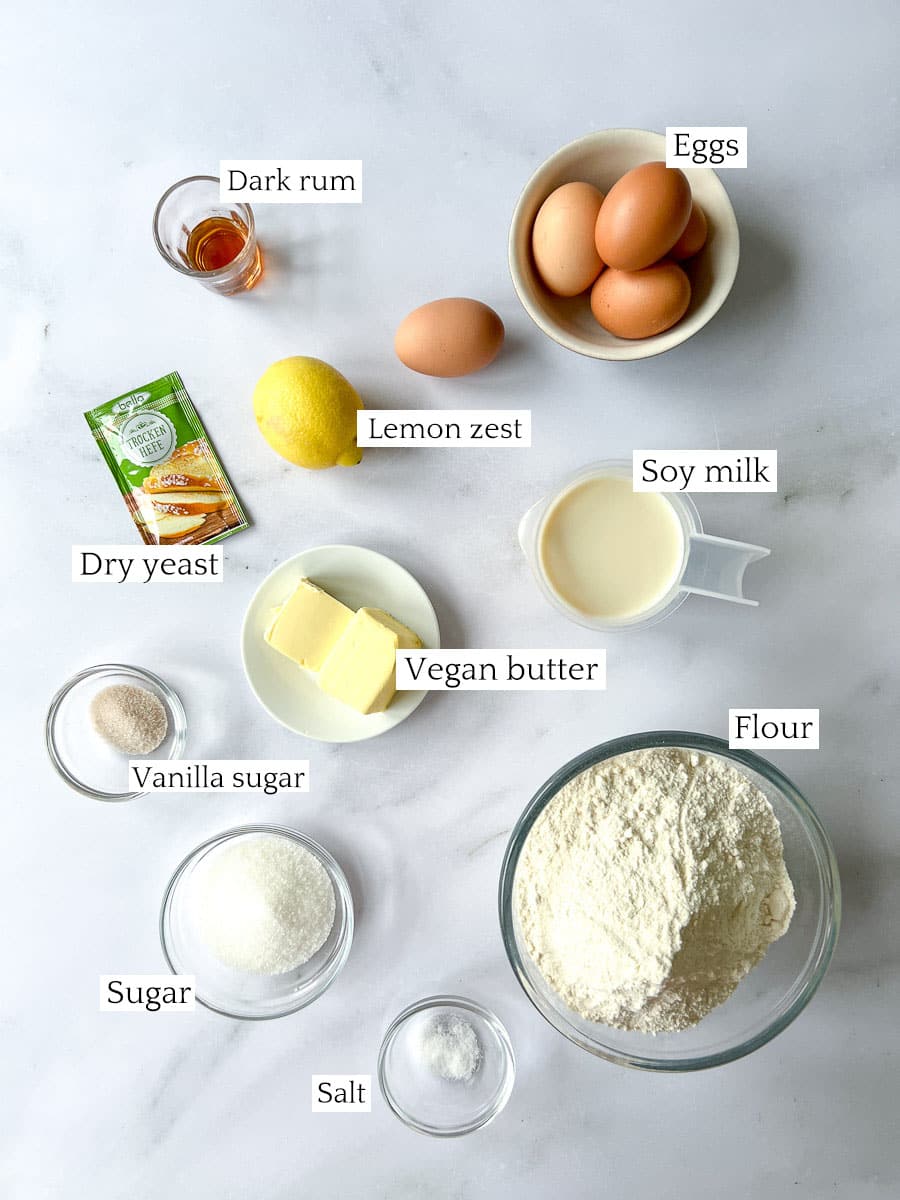
If you do not follow a dairy-free diet, you can use regular butter and regular cow milk instead.
How to make Dairy-Free Easter Egg Bread
Before you start, there are two main pointers:
- make sure your ingredients are room-temperature (eggs especially), and your soy milk is lukewarm. Remove them from the fridge 2 hours before starting and bring them to room temperature. Cold ingredients will keep the dough from rising and lengthen the rising process.
- Your room must be warm with no drafts or the dough will not rise well. If your dough is not rising, place it in the oven under the light and set the temperature to 30°C / 86°F.
Start by activating your yeast:
mix half of the soy milk with 1 teaspoon of flour, a pinch of sugar, and the dry yeast. Stir until fully combined, cover with a napkin, and set aside to proof for about 10 minutes until the yeast is bubbly and has doubled in volume. It should look like this (before and after):
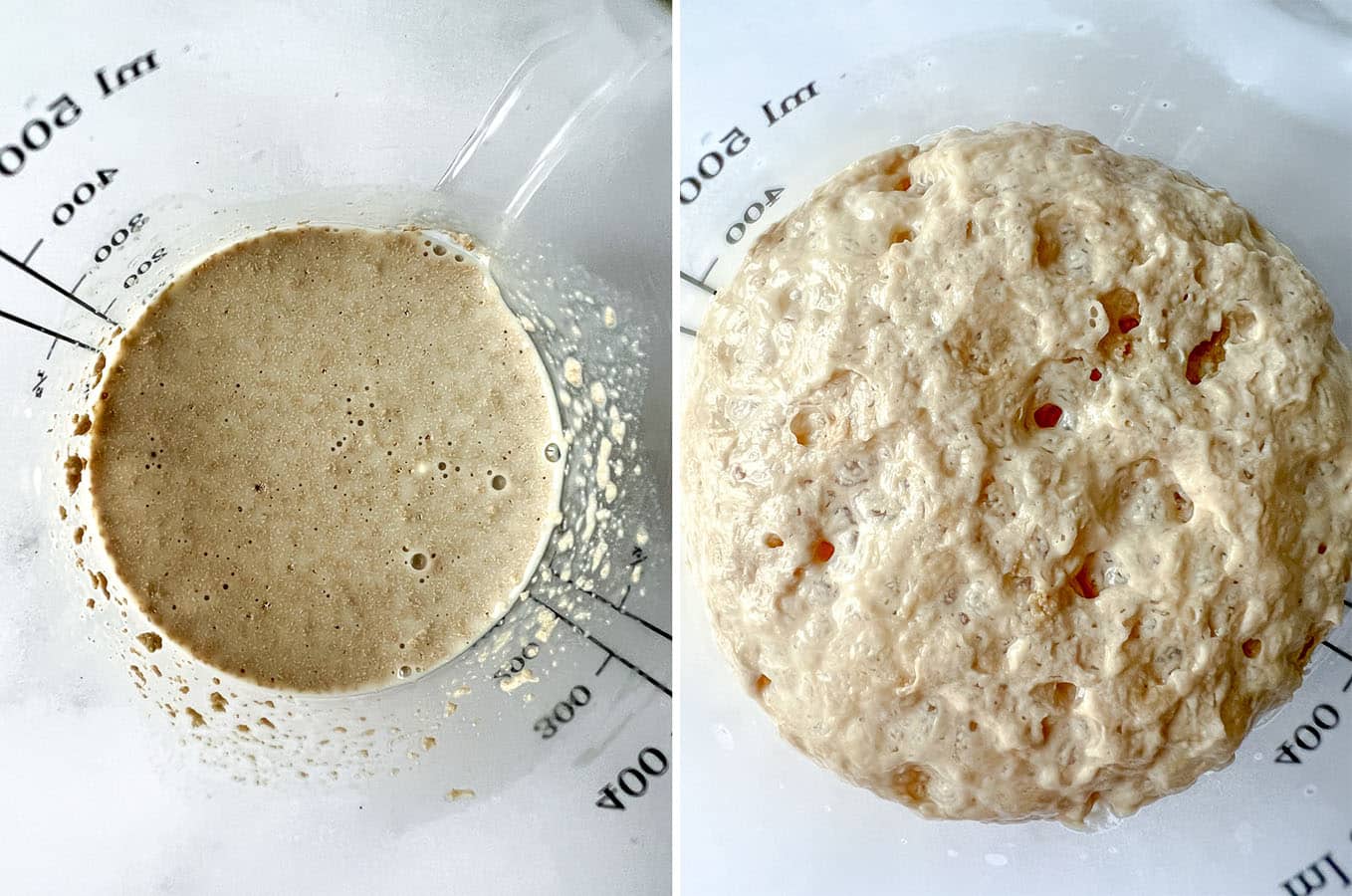
Whisk egg yolks and sugar until the mixture looks pale in color, thick, and foamy. Add rum, vanilla sugar, lemon peel, and melted butter. Whisk again until combined.
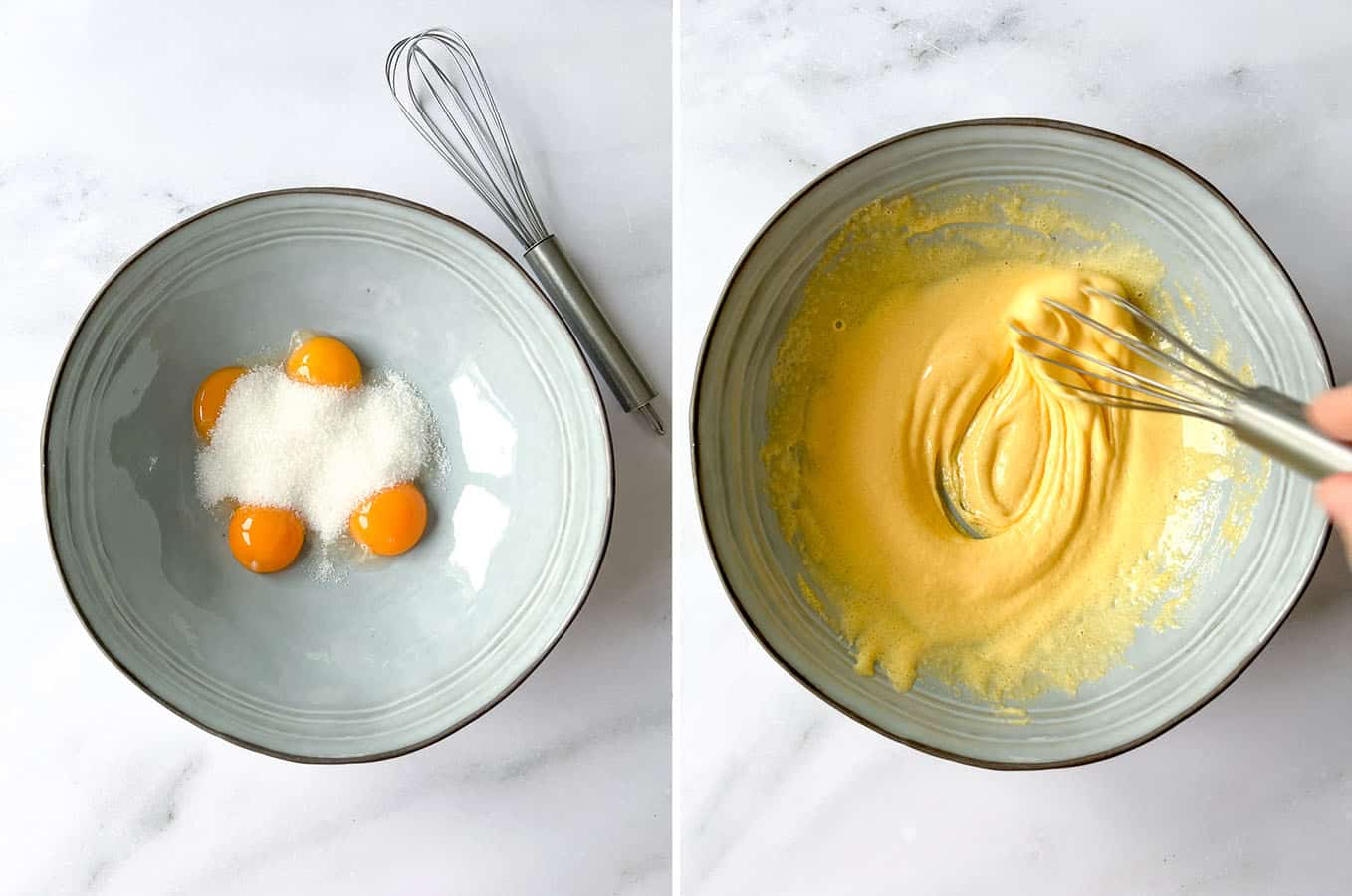
Add flour to a bowl and make a well in the middle. Sprinkle a pinch of salt on the edge of the bowl. Make sure the salt and yeast do not come into direct contact. Pour your yeast into the middle of the well, and stir it in the flour gently.
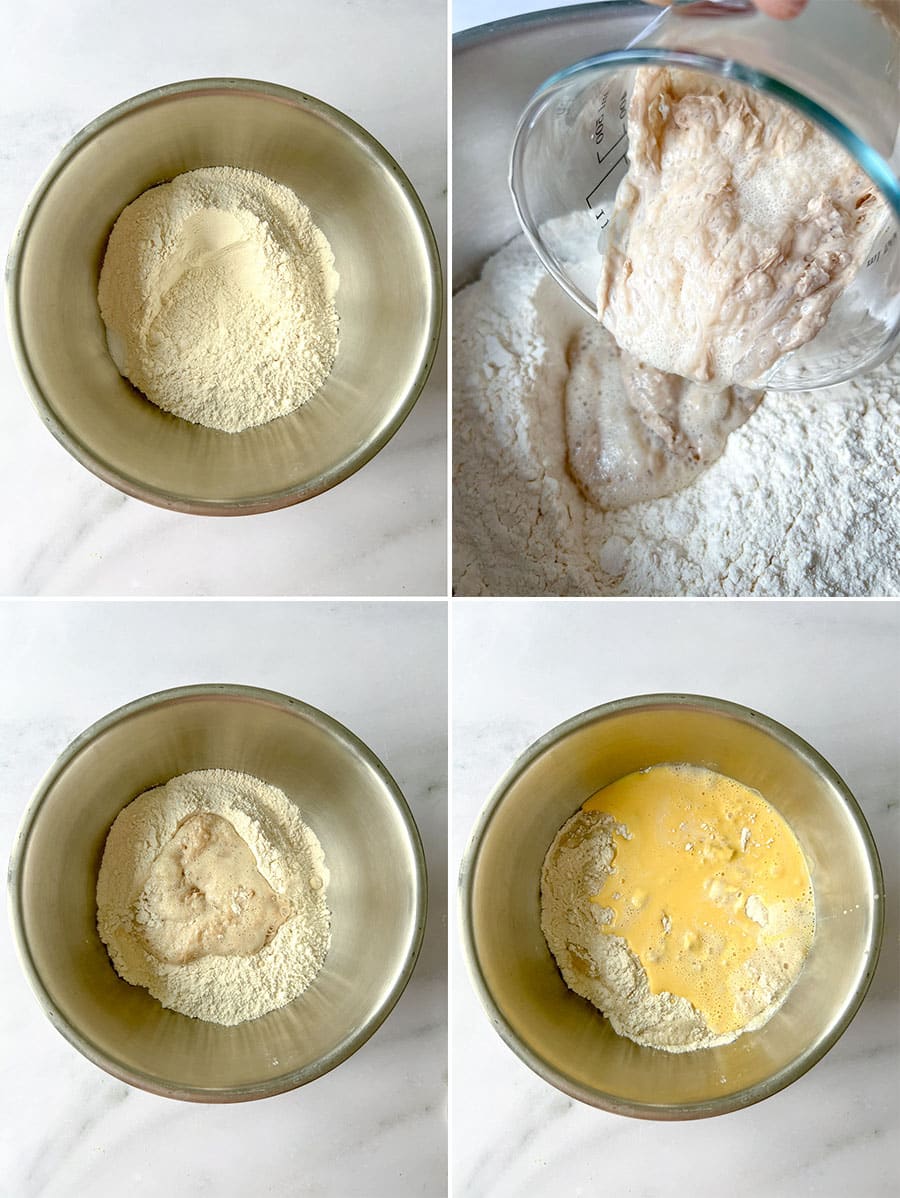
Then, add the egg mixture and the remaining soy milk and stir into the flour. It will start off being lumpy, but just continue mixing until the dough starts to stick together. Then, transfer the dough to a working surface dusted with a little bit of flour.
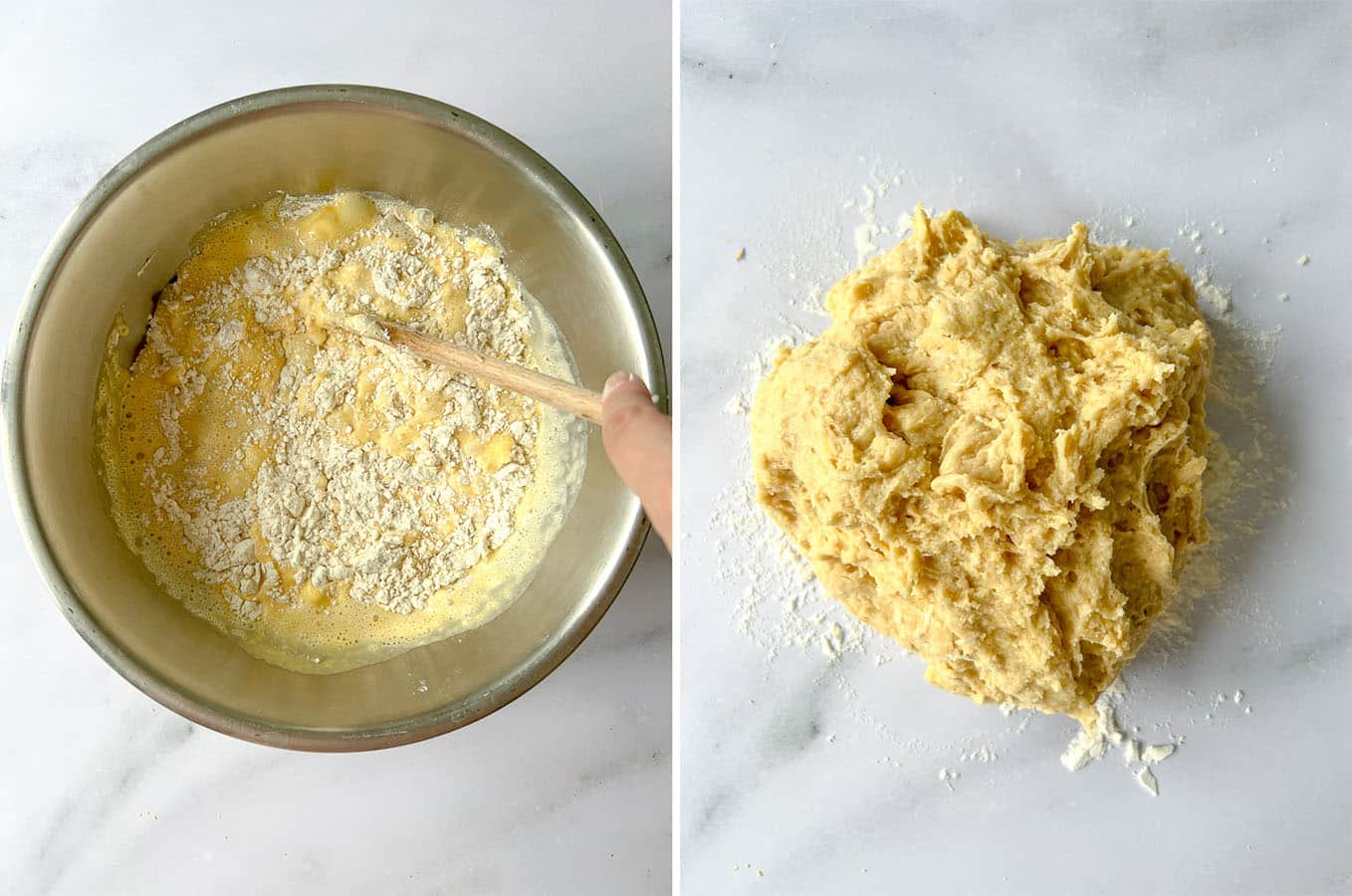
Continue by hand-kneading the mixture into a dough. The dough should be smooth, elastic, and just slightly sticky. But if the dough sticks to your hands, add a little flour, until it’s pliable.
Shape the dough into a ball, place it in a bowl, cover it with a kitchen towel or foil, and set it aside to proof for about 1-2 hours, or until doubled in size.
See notes for troubleshooting if your dough is not rising.
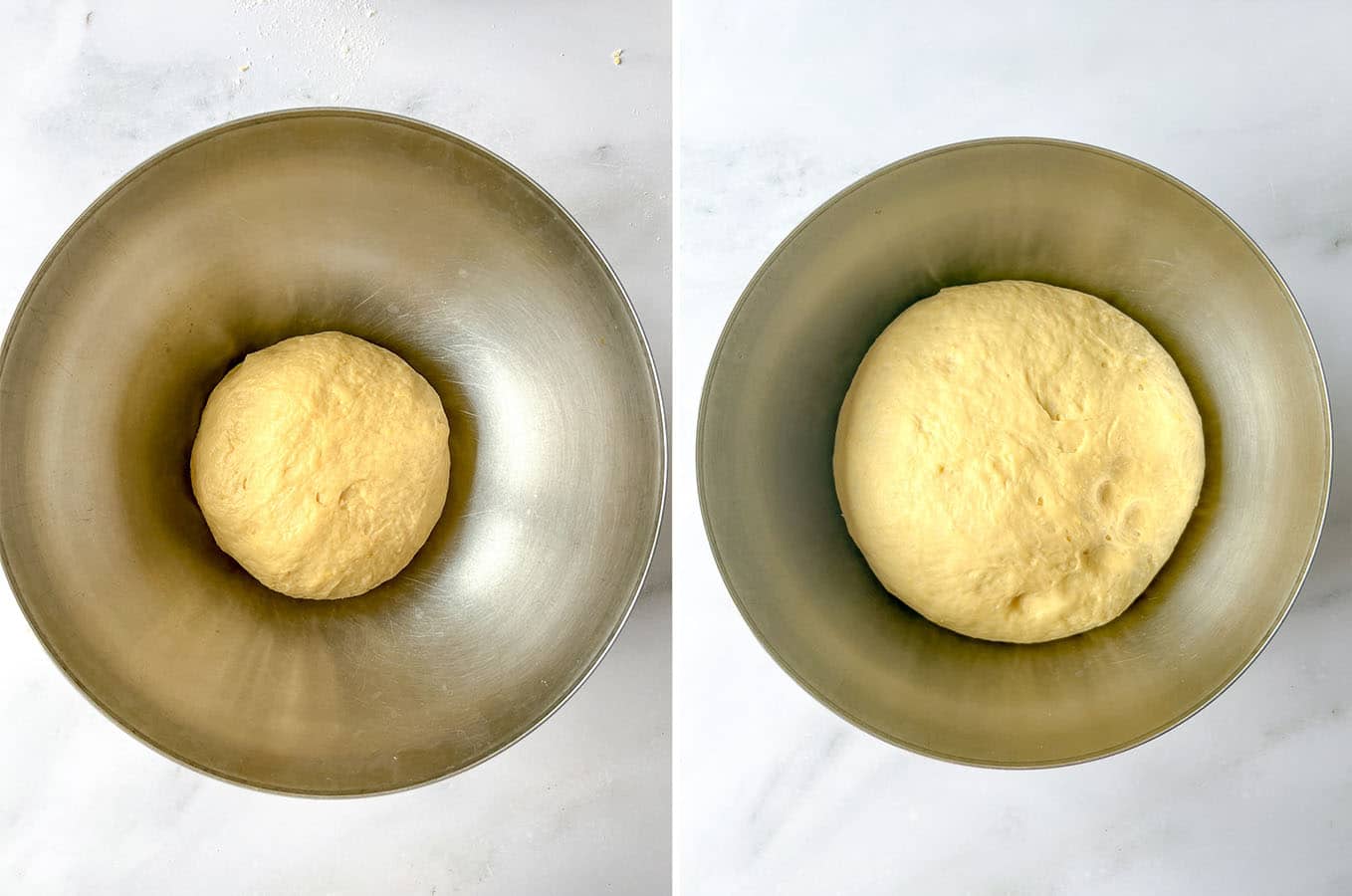
Meanwhile, preheat the oven to 180°C / 356°F.
Once your dough has risen, take it out, and divide it into 6 pieces. Shape into balls and place on your baking tray, pre-lined with parchment paper. Leave to proof for another 20 minutes.
Beat an egg into a bowl to make an egg wash. Spread it gently all over the dough balls (with a brush, or your hands) and cut a Y shape on top of the dough balls with a sharp knife.
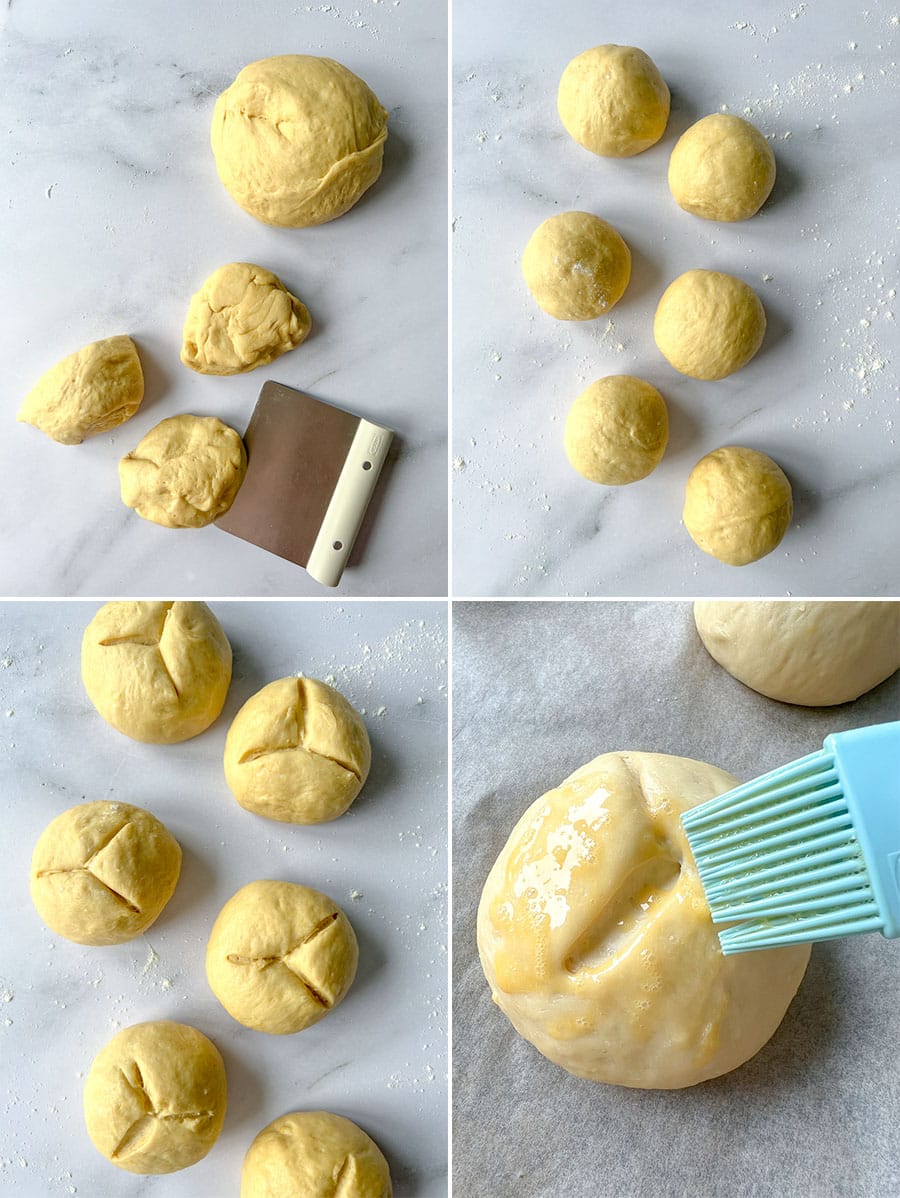
Optionally, you can now sprinkle the tops with some almond flakes.
Place in oven and bake for about 23-25 minutes until golden brown.
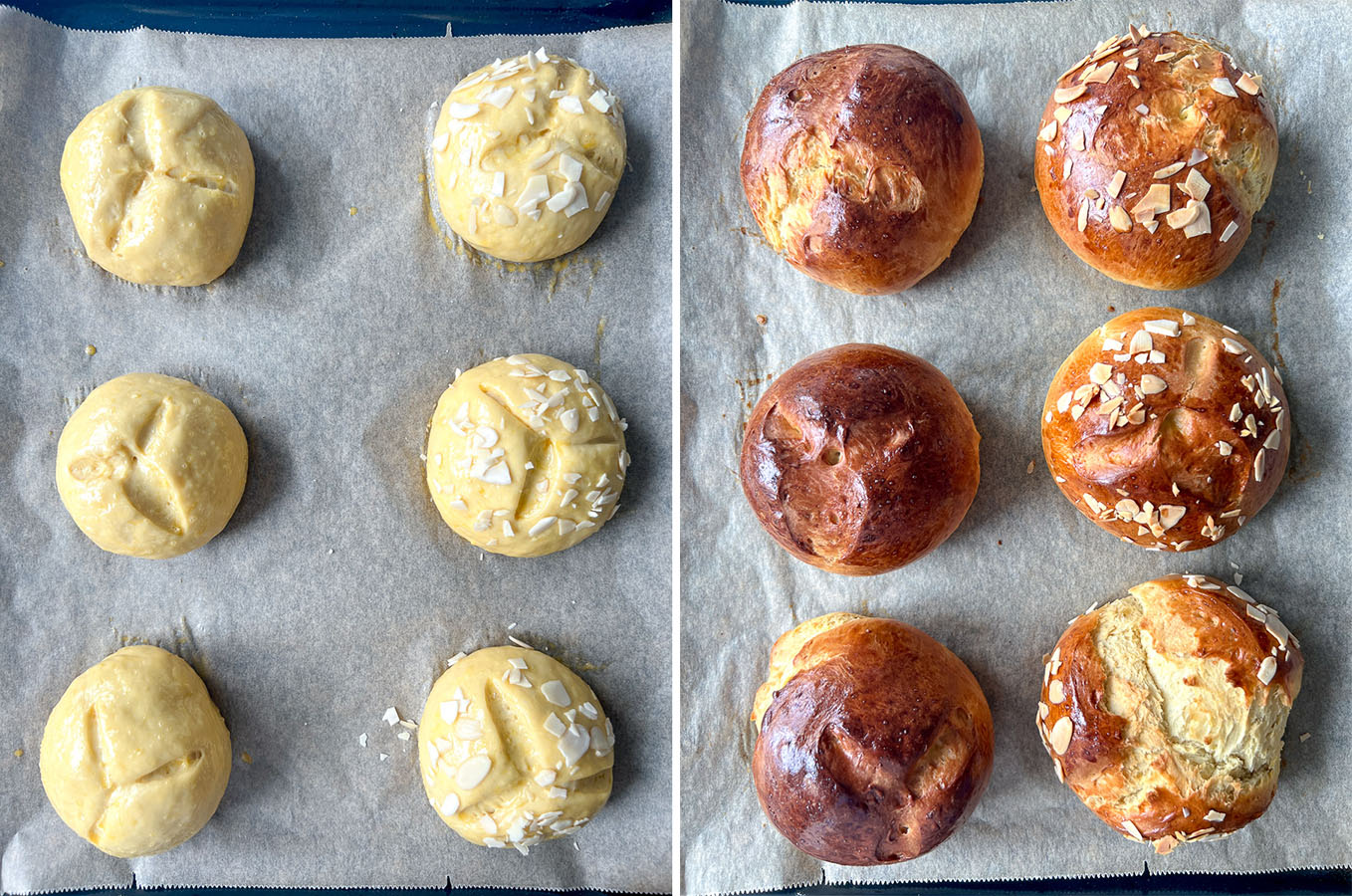
Remove from the oven and let the loaves of bread cool on a cooling rack.
Serving suggestions
This egg bread is best served within a day or two as it is made, but it can also be frozen to enjoy it at a later time (see storage tips for more information).
Include Easter egg bread as part of a festive brunch spread alongside other traditional Easter dishes such as ham (if consuming), deviled eggs, quiche, fresh fruit, and pastries. Arrange the bread slices on a serving platter or basket for guests to enjoy alongside other delicious treats.
We like to enjoy this easter bread as is, with a sip of coffee, or spread a little (vegan) butter on top. Some jam goes splendidly, too!
You can use slices of fresh Easter egg bread to make delicious sandwiches for lunch or snacks. Fill the bread with your favorite sandwich fillings such as vegan cheese, lettuce, tomato, and mayonnaise for a satisfying and flavorful meal.
Another splendid idea is to hollow out the center of a round loaf of Easter egg bread to create a bread bowl. Fill the bowl with colorful Easter eggs or fresh flowers for a festive centerpiece for your Easter table. This decorative touch adds a charming and whimsical element to your holiday spread.
You can also fill the bread bowl with a thick vegetable soup for a different serving idea.
When the bread is not the freshest, you can:
Slice and Toast: Serve slices of Easter egg bread lightly toasted and spread with butter or your favorite jam for a breakfast or brunch treat. The toasting enhances the bread’s flavor and texture.
French Toast: Use slices of stale Easter egg bread to make French toast. Dip the bread slices in a mixture of beaten eggs, plant milk, and a dash of cinnamon, then fry them in a skillet until golden brown and crispy. Serve with maple syrup, fresh berries, or powdered sugar. French toasting it will give stale bread a second life and reduce food waste.
Bread Pudding: Transform leftover Easter egg bread into a rich and comforting bread pudding. Tear the bread into bite-sized pieces and mix it with a custard mixture of eggs, plant milk, sugar, and vanilla extract. Bake until golden brown and serve warm with a drizzle of caramel sauce or a dollop of whipped coconut cream for a decadent dessert.
Whether served as part of a festive meal or enjoyed on its own, Easter egg bread is a delightful and versatile treat that adds a special touch to your Easter celebrations.
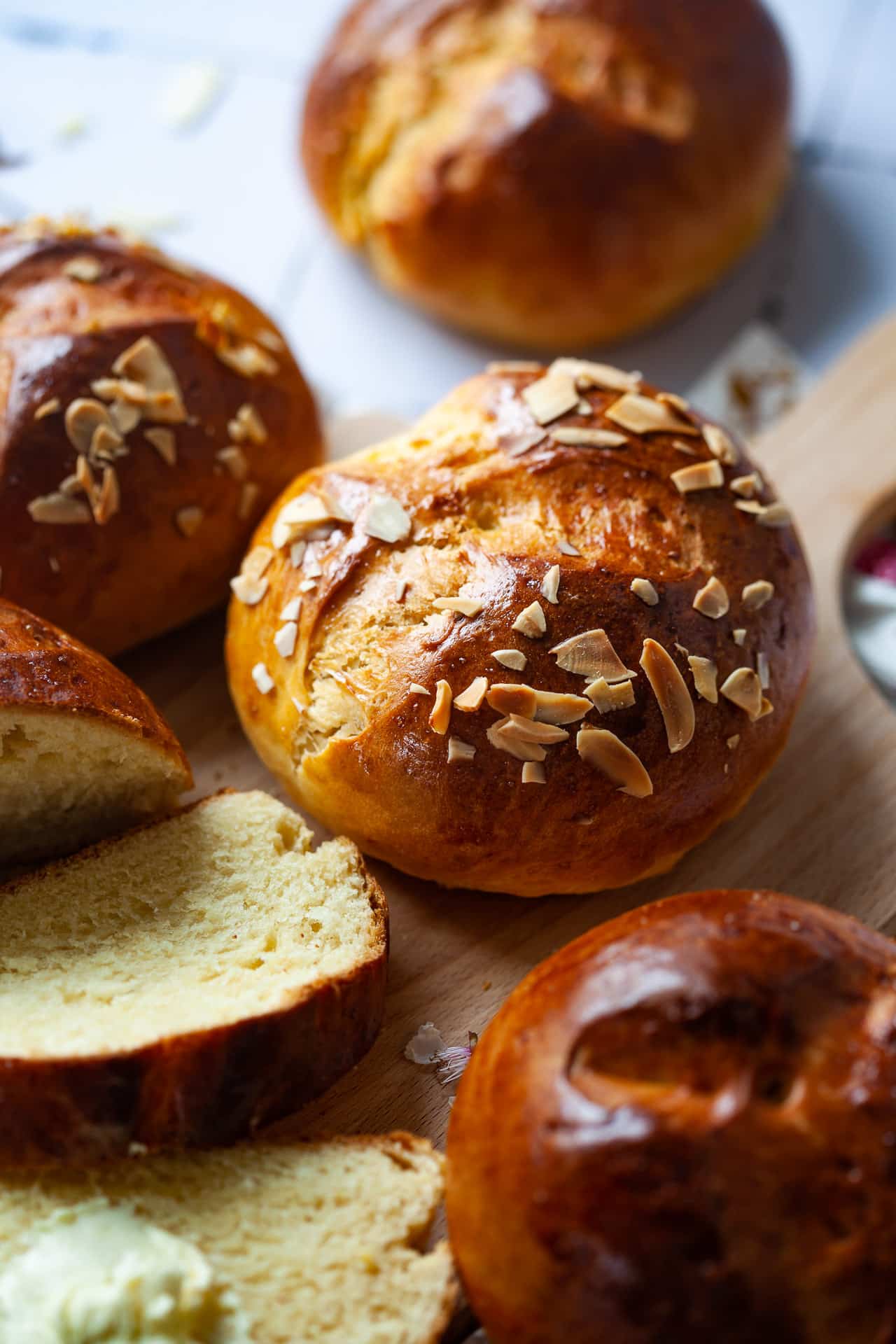
Storage tips
To maintain the freshness and quality of Easter egg bread, follow these storage tips:
Cool Completely:
Allow the Easter egg bread to cool completely to room temperature before storing it. This helps prevent condensation from forming inside the storage container, which can lead to soggy bread.
Once cooled, wrap the Easter egg bread tightly in plastic wrap or aluminum foil to protect it from air exposure and moisture. Alternatively, you can place the bread in a large resealable plastic bag.
Room Temperature:
Store the wrapped Easter egg bread at room temperature in a cool, dry place away from direct sunlight and heat sources. Avoid storing it in the refrigerator, as this can cause the bread to dry out more quickly.
Easter egg bread is best enjoyed within 2-3 days of baking for optimal freshness and flavor. If properly stored, it can last for up to 5 days at room temperature or up to 2 months in the freezer.
Freezing Option:
If you don’t plan to consume the Easter egg bread within a few days, you can freeze it for longer storage. Wrap the bread tightly in plastic wrap to prevent freezer burn. Place it in a freezer-safe bag or container, and label it with the date of freezing.
Thawing:
When ready to enjoy frozen Easter egg bread, remove it from the freezer and let it thaw at room temperature for several hours or overnight. To refresh the bread, you can warm it briefly in the oven at a low temperature or toast individual slices.
Reheating:
If you prefer warm Easter egg bread, you can reheat individual slices in the microwave for a few seconds, or in a toaster oven or air-fryer for a few minutes until warmed through. Be careful not to overheat the bread, as this can cause it to become dry.
By following these storage tips, you can prolong the shelf life of Easter egg bread and ensure that it remains delicious and enjoyable for longer periods.
Remember to check the bread for any signs of spoilage before consuming, and discard any leftovers that appear moldy or stale.
More Easter recipes:
Vegan Hot Cross Chocolate Buns
Vegan Pumpkin Spice Cinnamon Rolls
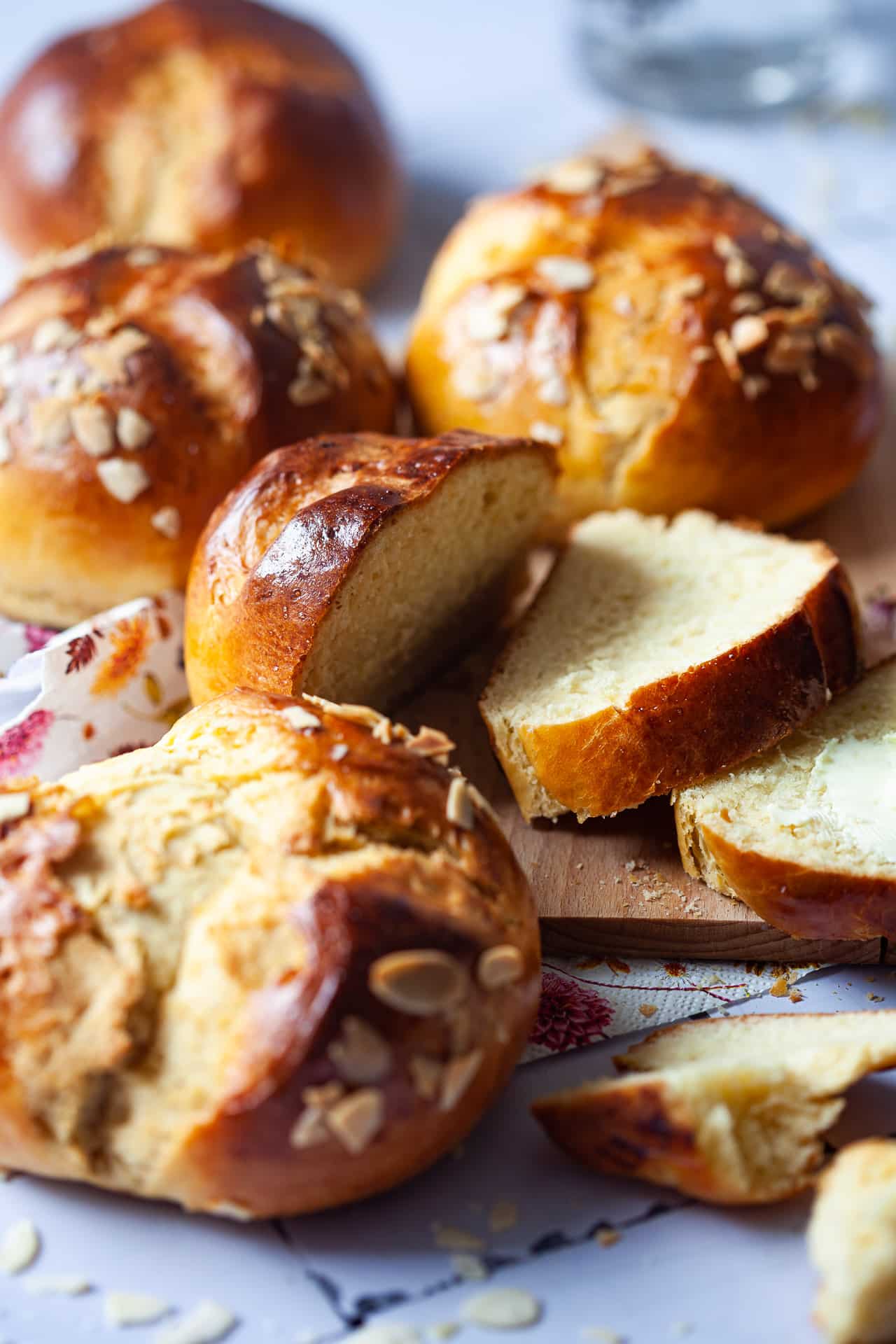
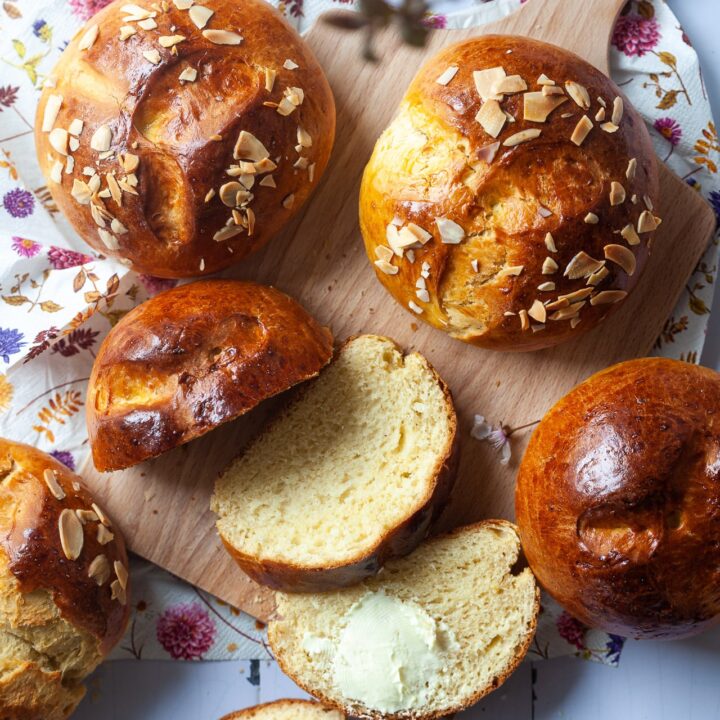
Dairy-Free Easter Egg Bread
This Dairy-Free Easter Egg Bread is our family's traditional recipe and my favorite Easter dish. Try this easy and quick recipe!
Ingredients
- 100 grams vegan butter
- 250 milliliters soy milk
- 4 egg yolks
- 70 grams sugar
- 8 grams of vanilla sugar
- 1 tsp dark rum
- 2 tsp lemon zest
- 7 grams of dry yeast
- 500 grams flour
- pinch of salt
- 1 egg
Instructions
- Prepare your yeast: mix half of the soy milk with 1 teaspoon of flour, a pinch of sugar, and the dry yeast. Stir until fully combined, cover with a napkin, and set aside to proof for about 10 minutes until the yeast is bubbly and has doubled in volume. You can also use fresh yeast (52 g).
- Melt the vegan butter. Whisk egg yolks and sugar until the mixture looks pale in color, and foamy. Add rum, vanilla sugar, lemon peel, and melted butter. Whisk again until combined.
- Add flour to a bowl and make a well in the middle. Sprinkle a pinch of salt on the edge of the bowl. Make sure the salt and yeast do not come into direct contact. Pour your yeast into the middle of the well, and stir it in the flour gently. Then, add the egg mixture and the remaining soy milk and stir into the flour.
- Continue by hand-kneading the mixture into a dough. The dough should be smooth, elastic, and just slightly sticky. But if the dough sticks to your hands, add a little flour, until it's pliable.
- Shape the dough into a ball, place it in a bowl, cover it with a kitchen towel or foil, and set it aside to proof for about 1-2 hours, or until doubled in size. See notes for troubleshooting if your dough is not rising.
- Once your dough has risen, take it out, and divide it into 6 pieces. Shape into balls and place on your baking tray, pre-lined with parchment paper. Leave to proof for another 20 minutes.
- Meanwhile, preheat the oven to 180°C / 356°F.
- Beat an egg into a bowl to make an egg wash. Spread it gently all over the dough balls (with a brush, or your hands) and cut a Y shape on top of the dough balls with a sharp knife. Optionally, you can now sprinkle the tops with some almonds flakes.
- Place in oven and bake for about 23-25 minutes until golden brown in color.
- Remove from the oven and let the loaves of bread cool on a cooling rack.
Notes
Before you start baking make sure your ingredients are room-temperature or lukewarm (for soy milk). Remove them from the fridge 2 hours before starting.
Your room must be warm with no drafts. If your dough is not rising well, place it in the oven under the light and set the temperature to 30°C / 86°F.
Nutrition Information:
Yield: 6 Serving Size: 1Amount Per Serving: Calories: 548Total Fat: 19gSaturated Fat: 11gTrans Fat: 1gUnsaturated Fat: 7gCholesterol: 193mgSodium: 169mgCarbohydrates: 80gFiber: 3gSugar: 15gProtein: 14g
Nutrition data is automatically calculated using Nutritionix and may not be accurate.

